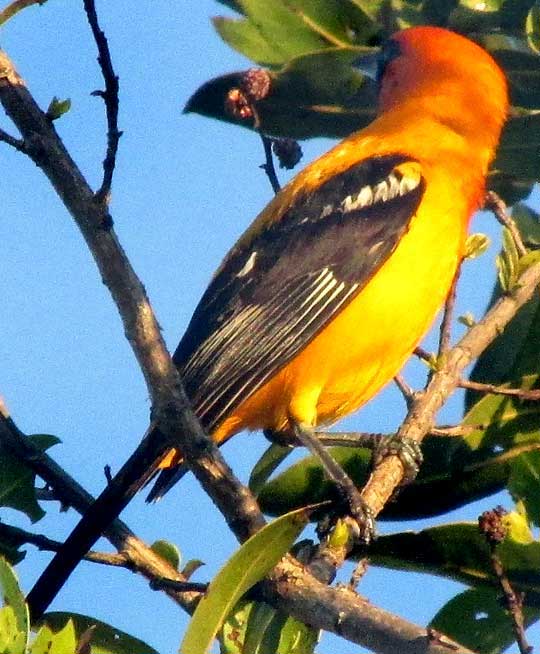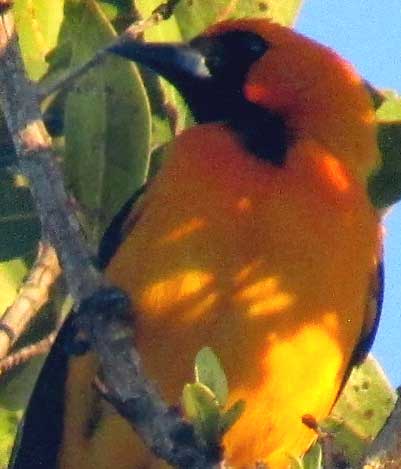Excerpts from Jim Conrad's
Naturalist Newsletter
from the June 14, 2015 Newsletter issued from Río Lagartos, on the Yucatan Peninsula's northern coast (~N21.60°, ~W88.16°), Yucatán state, MÉXICO
ORANGE ORIOLE
I was camping in the salt marshes where during most of the year there's shallow water but now, despite recent rains, it's still dry and open. Here and there dense tangles of Buttonwood Mangrove and Poisonwood formed islands of woody vegetation, or hammocks. That morning as the sun came up an oriole landed in a Buttonwood beside my tent, as shown below:

In this area whenever you see an orangish (not yellowish) oriole with an orangish back, you know two things: First, it's a mature male, because females and immatures are more yellowish. Second, you need to pay close attention, because we have two very similar species in which the males have orangish backs, and one of them, the Orange Oriole, is endemic just to the Yucatan Peninsula. The other, the Hooded Oriole, is much more generally distributed, found from the southwestern US through most of Mexico to northern Belize. So, which was this?
Most of us find it hard to distinguish the two species if the birds are yellowish immatures or females, even when they offer good views and stay still. In those birds the field mark to look for is the Orange Oriole's straight bill, to be compared to the Hooded Oriole's slightly down-curved bill. So, in the above picture, is the bill straight or curved? A better look is provided below:

It's straight most of the way, but then curved toward the tip. Field guides show Orange Oriole beaks a little curved at the tip, so the beaks aren't absolutely straight, but Hooded Oriole beaks aren't really too curved, either. Also, the black face masks on Orange Orioles are a little less extensive than those on Hooded Orioles, but that's hard to judge. Other such vague, intergrading differences also could be mentioned, which helps someone familiar with the birds, but leave beginners wondering.
Happily, when you have male adults like ours, all these ambiguous field marks can be ignored, for only the adult male Orange Oriole's back is orange; adult male Hooded Oriole backs are black or blackish. Our orange-backed bird is definitely an endemic Orange Oriole, ICTERUS AURATUS, whether its bill is straight or not, or its face mask more or less extensive.
This endemic species is fairly common in our area wherever open areas with scattered trees occur. The farther south in the Peninsula you go, the less common they become. At the Inaturalist.Org website the Spanish description of the bird describes the Orange Oriole as the only species within the genus Icterus that nests colonially. In the field they often wander with other oriole species.
Orange Orioles look like Hooded Orioles, but their song is a pretty, varied series of clear, plaintive whistles similar to the Altamira Oriole's.
With such similar-looking species, sometimes you wonder whether the two forms really deserve to be called distinct species. In this case, the Orange Oriole's behavior makes it clear that it's a real, separate species.